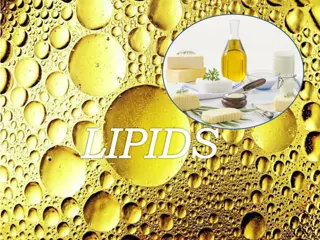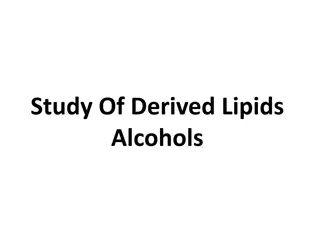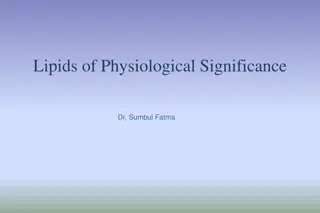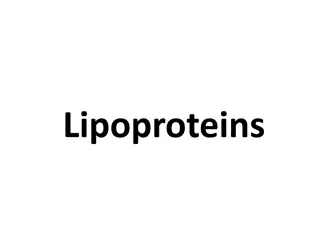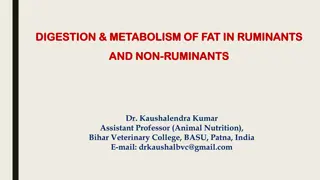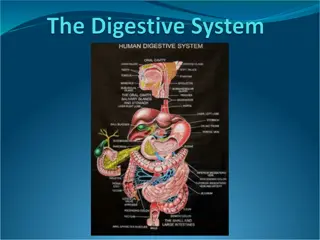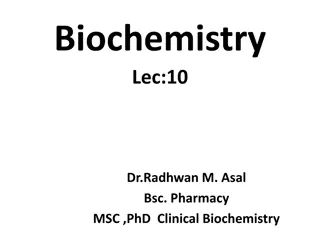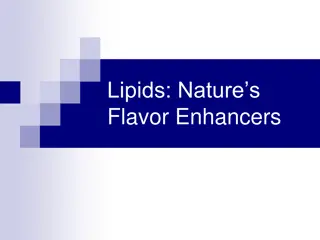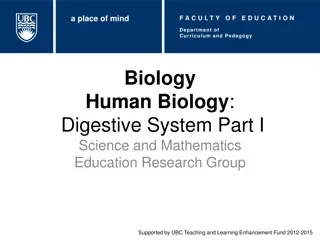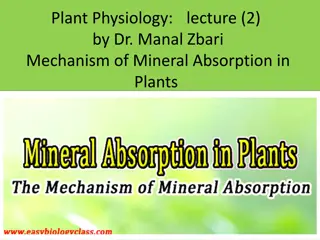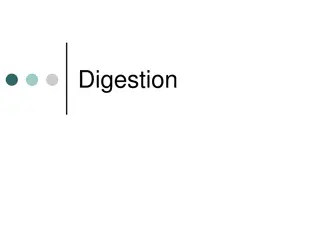Understanding Lipids: Importance, Digestion, and Absorption
Professor Shraddha Singh's lecture series delves into the significance of lipids, the types of lipids, and the role of bile in digestion. Learn about saturated vs. unsaturated fatty acids, common fatty acids found in lipids, lipid structures, and properties. Explore the diverse types of fats we consume, with a focus on triglycerides and other lipid molecules.
Download Presentation

Please find below an Image/Link to download the presentation.
The content on the website is provided AS IS for your information and personal use only. It may not be sold, licensed, or shared on other websites without obtaining consent from the author. Download presentation by click this link. If you encounter any issues during the download, it is possible that the publisher has removed the file from their server.
E N D
Presentation Transcript
Lecture series Gastrointestinal tract Professor Shraddha Singh, Department of Physiology, KGMU, Lucknow
Learning objectives To convince that how the lipids are important! To describe the major types of lipids To understand the role of bile in digestion of lipids To describe emulsification of lipids by bile salts To explain how fatty acids are absorbed To understand micells formation and chylomicrons
What are lipids Lipid = a compound that is insoluble in water, but soluble in an organic solvent (e.g., ether, benzene, acetone, chloroform)
Saturated vs. Unsaturated Fatty Acids saturated: the SFA s of a lipid have no double bonds between carbons in chain polyunsaturated: more than one double bond in the chain most common polyunsaturated fats contain the polyunsaturated fatty acids (PUFAs) oleic, linoleic and linolenic acid unsaturated fats have lower melting points
Fatty Acids Commonly Found in Lipids Melting Point (oC) Liquid 63 70 Melting Point (oC) Liquid Liquid Liquid Sat. Fatty Acids Butyric Palmitic Stearic Unsat. Fatty Acids Oleic Linoleic Linolenic Formula C4H8O2 C16H22O2 C18H36O2 Formula C18H34O2 C18H32O2 C18H30O2
Structure of lipids They are composed of carbon, hydrogen, and a smaller amount of oxygen. Some lipids also contain small but functionally important amounts of nitrogen and phosphorus
Properties of Lipids Thus, lipids have been classified according to their physicochemical interactions with water. Lipids may be either nonpolar and completely insoluble in water (e.g.cholesteryl esters and carotene) polar and amphiphilic,that is, having both polar (hydrophilic) and nonpolar (hydrophobic) groups.
Types of fats we use More than 95% are triglycerides, the other are Cholesterol, Cholesteryl esters, Phospholipids, and Unesterified fatty acids.
Sources of Lipids Vegetable Sources Animal Sources Cooking oils- Sun flower oil, Dairy products- butter, ghee Mustard oil, Ground nut oil Meat and Fish, Pork, eggs Fats from other vegetable sources Additional lipid is supplied in the form of phospholipids and cholesterol, mostly arising from the liver in biliary secretions
Triglyceride degradation Triglycerides are degraded by lipases to form free fatty acids and glycerol
Digestion of fat in Mouth Hydrolysis of triacylglycerol is initiated by lingual lipases, which attack the sn-3 ester bond forming 1,2-diacylglycerols and free fatty acids Lingual lipase: Secreted by dorsal surface of tongue Active at low pH (pH 2.0 7-5) optimum pH 4.0-4.5 Ideal substrate-Short chain TGS.
Digestion of fat in Stomach Gastric Lipase- secreted in small quantities More effective at alkaline p H (Average p H 7.8) Requires the presence of Ca++ Not effective for long chain fatty acids, most effective for short and medium chain fatty acids
Significance of Lingual and Gastric Lipases Free fatty acids produced by lipases initiates secretion of CCK Play an important role in lipid digestion in neonates since milk is the main source of energy Lingual and gastric lipases can degrade triglycerides in patients with pancreatic disorders despite a near or complete absence of pancreatic lipase
Digestion of fat in duodenum Free fatty acids produced by gastric lipases initiates secretion of CCK Stimulates contraction of the Gall bladder Relaxes sphincter of Oddi. Release of bile in to duodenum Bile salts starts emulcification of fats
Emulsification and digestion Bile salt are responsible for lowering the surface tension allowing to formation of emulsion, The critical process of emulsification takes place in the duodenum. This emulsification provide more site for lipases to act
Digestion in small intestine Major site of fat digestion is small intestine Effective digestion due to the presence of Pancreatic lipase (that is activated by bile acids) cholesterol esterase catalyzes the hydrolysis of cholesterol esters, esters of fat-soluble vitamins, and phospholipids, as well as triglycerides. Bile salts act as effective emulsifying agents for fats Secretion of pancreatic juice is stimulated By secretion of Secretin, Cholecystokinin
Role of Bile Salts Bile salts help in combination of lipase with two molecules of a small protein called as Colipase. This combination enhances the lipase activity.
Triacyl glycerol degradation by pancreatic lipase Pancreatic lipase is specific for the hydrolysis of primary ester linkages(Fatty acids present at position 1 and 3) It can not hydrolyze the ester linkages of position -2 Digestion of Triglycerides proceeds by removal of a terminal fatty acid to produce an , diglyceride
Absorption of Lipids Glycerol, short and medium chain fatty acids (Chain length less than 14 carbons) are directly absorbed from the intestinal lumen . Their uptake is regulated via the activity of specific membrane transporters, a microvillus membrane fatty acid binding protein (MVM-FABP) provides for the uptake of long-chain fatty acids across the brush border. Long chain fatty acids, free cholesterol and - acyl glycerol together with bile salts form mixed micelles.
Micelles Bile salts are amphipathic , one surface of the molecule is hydrophilic because the polar peptide bond and the carboxyl and hydroxyl groups are on that surface, whereas the other surface is hydrophobic. Therefore, the bile acids tend to form cylindrical disks called micelles.
Micelles formation When the concentration of bile acids in the intestine is high, as it is after contraction of the gallbladder, lipids and bile salts interact spontaneously to form micelles
Micelles Micelles are disk shaped clusters of amphipathic lipids that coalesce with their hydrophobic groups on the inside and their hydrophilic groups on the outside of clusters Mixed micelles are soluble in the aqueous environment of the intestinal lumen Thus, the micelles move down their concentration gradient through the brush border of the mucosal cells.
Fate of fatty acids The fate of the fatty acids in enterocytes depends on their size. Fatty acids containing less than 10 12 carbon atoms are water-soluble enough that they pass through the enterocyte unmodified and are actively transported into the portal blood. The fatty acids containing more than 10 12 carbon atoms are re-esterified to triglycerides in the enterocytes. The triglycerides and cholesterol esters are then coated with a layer of protein,cholesterol, and phospholipid to form chylomicrons
Fate of lipids inside enterocytes These leave the cell and enter the lymphatics, by exocytosis because they are too large to pass through the junctions between capillary endothelial cells
Chylomicrons Once again , inside the enterocyte, monoglycerides and fatty acids are re-synthesized into TG. Chylomicrons are lipoproteins, special particles that are designed for the transport of lipids in the circulation. Chylomicrons are released by exocytosis at the basolateral surface of the enterocytes. Because they are particles, they are too large to enter typical capillaries. Chylomicrons then flow into the circulation via lymphatic vessels.
References Lippincott s Illustrated Reviews: Physiology (2013) Medical Physiology, Updated second edition (walter F. Boron, MD, phd) Berne & levy, physiology, sixth edition, updated edition Ganong s Review of Medical Physiology, 26 t h e d i t i o n



